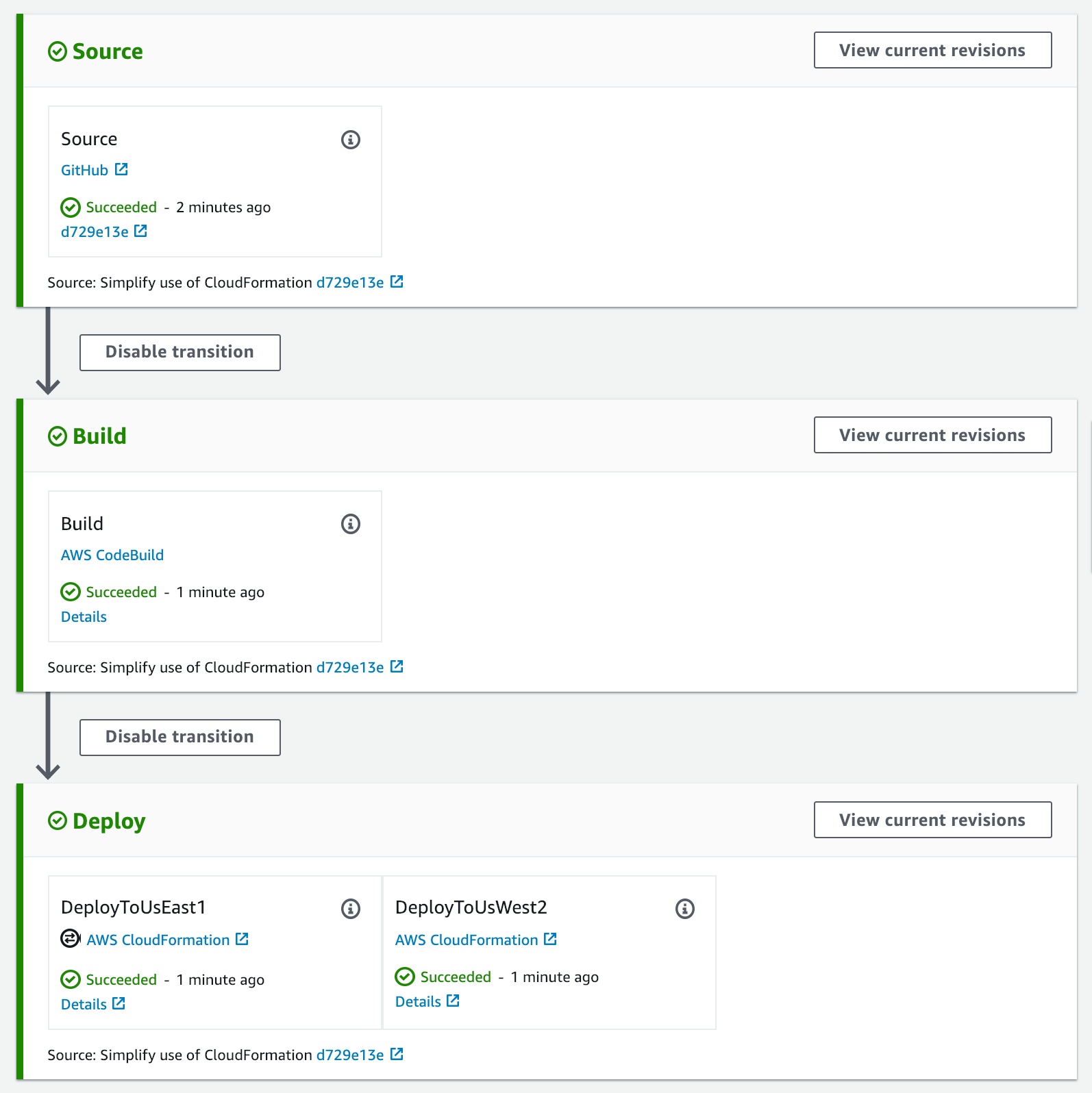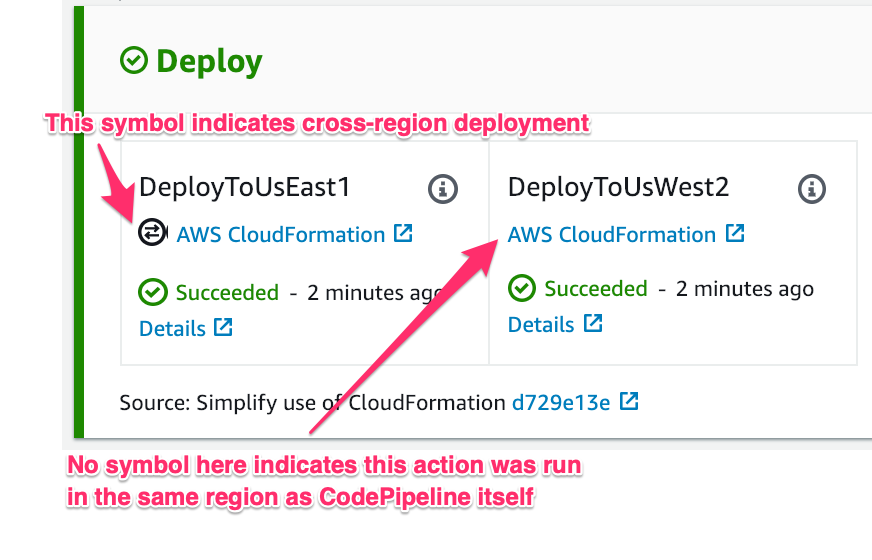This is a "walking skeleton" application that you can modify to create a continuously deployed AWS application using AWS CodePipeline, to multiple AWS regions. If you don't know what "AWS Regions" or CodePipeline are, or why you might want them, then you might want to do some Googling before using this example.
The following core AWS services are used in example.
- The application is a simple AWS Lambda function (defined in
template.yaml), that is deployed using SAM / CloudFormation. This is purely an example - the same technique can be used for significantly more complicated applications. - The deployment pipeline is implemented using AWS CodePipeline (defined in
deployment-pipeline/pipeline.yaml) - The deployment pipeline makes use of AWS CodeBuild, defined within the pipeline template, plus also
deployment-pipeline/buildpec.yaml, using the build scriptmultiregion-build.sh
In summary, by using this example you will have a continuously deployed application, targeting multiple AWS regions, using only AWS services, a single CodePipeline instance, and zero custom tasks or custom resources.
The documentation with this example assumes you have a working knowledge of using the AWS CLI from a terminal, CloudFormation, and some modicum of familiarity of CodePipeline and CodeBuild.
-
Fork this repository to your own GitHub repository (or elsewhere.)
-
By default the application will use the Github repository
symphoniacloud/multi-region-codepipelineas its source repository. Update theGitHubOwnerandGitHubRepodefault parameter values indeployment-pipeline/pipeline.yamlfor your values. Alternatively if you're not using Github then change the PipelineSourcestage (but that's out of scope for this readme.) -
Assuming you are using GitHub then create a new GitHub personal access token for this application. See here for how to do this - CodePipeline needs just the
reposcope permissions. I recommend you name the token for this particular pipeline, at least to get started, and that you store the token somewhere safe, like a password manager. -
By default the application CloudFormation stack will be named
multi-region-codepipeline-app, and the CodePipeline stack will be namedmulti-region-codepipeline. If / when you want to change these then update the following files, looking for references tomulti-region-codepipeline:deployment-pipeline/create-artifact-buckets.shdeployment-pipeline/create-pipeline.shdeployment-pipeline/update-pipeline.shdeployment-pipeline/artifact-buckets.yamldeployment-pipeline/pipeline.yamlpackage.jsontemplate.yaml
-
By default the application will be deployed to us-east-1 (N Virginia) and us-west-2 (Oregon). If / when you want to change this list then update the following files, looking for references to these regions:
deployment-pipeline/create-artifact-buckets.shdeployment-pipeline/pipeline.yamldeployment-pipeline/buildspec.yamlmultiregion-build.sh
-
Commit all your changes to source control
-
Now from a terminal run the following (this assumes the AWS CLI is installed and configured). Make sure the terminal is configured to use the AWS region where you want the pipeline itself to run (or override using the
--regionflag), and that it is configured to use the account where the pipeline and application will run:
$ cd deployment-pipeline
$ ./create-artifact-buckets.sh
# Check new buckets have been created in correct regions in S3 console. Take the prefix,
# everything up to `-region-name`, and use that as the second argument below
$ ./create-pipeline.sh YOUR-GITHUB-TOKEN ARTIFACT-BUCKET-NAME-PREFIXOnce you've run this last command then watch both the CloudFormation and then CodePipeline consoles to evaluate whether the process has been successful.
To test everything, after the pipeline has successfully completed it's first run, check that you have new lambda functions named MyLambdaFunction-GENERATEDSTACKNAME in each of your target regions. You can execute these Lambdas from the Web Console using any test event as input.
When you need to update the application code or structure (as defined in template.yaml), or when you need to change how the application is built (either in the multiregion-build.sh or deployment-pipeline/buildspec.yaml files), then simply pushing your changes to source control will be sufficient - CodePipeline references these files from source on every pipeline run.
If you need to change the structure of the CodePipeline itself then run deployment-pipeline/update-pipeline.sh with the same arguments that you ran create-pipeline.sh.
If you need to add or change regions, then do the following:
- Update the 4 files listed above in step 5 under creating the pipeline, changing the regions where referenced
- If you are adding regions, then change
create-artifact-buckets.shto just specify the regions that you are adding - Re-run
create-artifact-buckets.sh, and then update the pipeline as described above.
Back in the dim an distant past of 8 weeks ago (before November 12 2018), it was not possible to use CodePipeline for cross-region actions, and so if you wanted to do multi-region CD you either needed to create a CodePipeline for each region (bleurgh), create custom workflow (sigh), or not use CodePipeline (whaaah!)
But as of November 2018 CodePipeline supports "Cross-Region Actions", meaning none of the above work-arounds are necessary. Huzzah! If you look in deployment-pipeline/pipeline.yaml you'll see the new Region: property being used on the "Deploy" actions. We duplicate the deploy actions for each region, parallelizing them to speed up the total deployment process.
So Multi-region CD is now easy on AWS, right? Well, no, not quite, there are still some friction points.
The main concern is that if you're deploying using CloudFormation / SAM, then you are still hamstrung by CloudFormation's limitation that the template and resources used during a CloudFormation deployment must be in a bucket in the same region that the CloudFormation stack is deployed to. In other words if you're deploying to us-west-2 then the CloudFormation template, and artifacts it references, must also be in a bucket in us-west-2, and by extension you need a separate artifact bucket per region you're deploying to.
The new cross-region CodePipeline support helps somewhat with this in that you can now provide a set of ArtifactStores, with one ArtifactStore per region. CodePipeline will automatically sync up the ArtifactStores during the course of the pipeline run. If you look in deployment-pipeline/pipeline.yaml you'll see the new ArtifactStores: property being used on the CodePipeline resource.
However, we're still left with two problems:
- How do we create the artifact store buckets in the first place?
- How do we create packaged applications for each region?
The first of these is a problem because you can't create S3 buckets in a CloudFormation template outside of the current region. For a single-region pipeline you can create an S3 bucket inline in the same template that the CodePipeline resources are defined in; with multi-region you can't. That means we need to create the buckets before creating the pipeline.
For this reason this example app includes the artifact-buckets.yaml template, and the create-artifact-buckets.sh script, which needs to be run before creating the pipeline.
It's possible that this might be fixable with a CloudFormation custom resource, but I haven't investigated that.
The last problem is that we need separately packaged applications per region. I'm using SAM here, and specifically the aws cloudformation package command during the CodeBuild stage. We could run CodeBuild once per region, just like we're running CloudFormation once per region during the deployment stage, but that's a little wasteful for CodeBuild, especially for when our build times get longer.
So instead, during the build stage, we run aws cloudformation package once per region , using the --region flag (see multiregion-build.sh, which is itself is referenced by the CodeBuild build spec deployment-pipeline/buildspec.yaml). This creates all of our artifacts, and now our application can happily be deployed.
So, in summary, here's how this works:
- Create pipeline S3 artifact buckets as prerequisites
- Within the pipeline run CodeBuild in the primary region (the same region as CodePipeline itself), but produce artifacts during the Build stage for all regions, using the
--regionflag atcloudformation packagetime - Use the CodePipeline
ArtifactStoresconstruct, along with multiple parallel deployment actions each using theRegion:property.
- Delete the application stacks from all regions
- Delete all artifact buckets
- Delete the pipeline stack
If you have any questions, comments, additions or suggestions please feel free to comment through GitHub, on twitter at @mikebroberts, or via email at mike@symphonia.io.
If your company is looking for help using CodePipeline, CloudFormation, or architecture using AWS then please contact us at Symphonia.
- Sort out IAM permissions in pipeline.yaml
- Consider using CDK version (better for repetition of resources)
- Consider custom resources, or something else, to allow cross-region buckets to be managed in
pipeline.yamlfile

